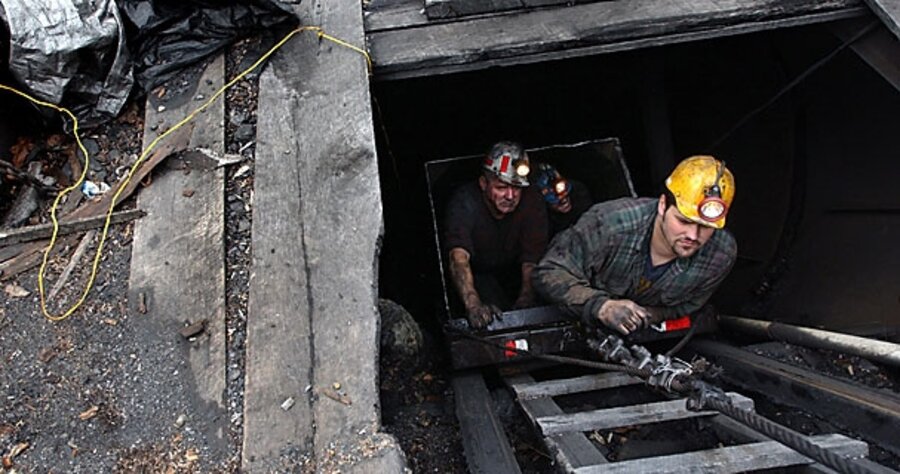What is 'clean coal,' anyway?
Loading...
Call it a hat trick: The phrase "clean coal" turned up in all three presidential debates, with both McCain and Obama supporting it. It turned up four times if you count the vice-presidential debate.
And woe betide any politician who doesn't appear to be in favor of it. Speaking Tuesday in Joe Biden's hometown of Scranton, Pa., Sarah Palin blasted the Democratic vice-presidential candidate for telling an activist in Ohio last month that the Obama campaign doesn't support clean coal. Biden says that his comments, which were posted on YouTube, were taken out of context. Since then, Biden has been emphasizing his pro-clean-coal Senate record, and reiterating his and Obama's support for the stuff.
But what exactly is clean coal? And why are all the candidates so quick to proclaim their support for it?
To answer both those questions: It's a vague concept with positive connotations. And it's a vague concept with positive connotations.
"Clean coal" means different things to different people, and the meaning seems to shift over time. Prior to World War II, the term was sometimes used to describe the high-quality "smokeless coal" that was sold for use in the home.
Later in the 20th century, the term morphed into something new. The 1990 Clean Air Act defined clean coal technologies as those that achieve "significant reductions in air emissions" of sulfur dioxide and nitrogen oxides, pollutants that contribute to the formation of acid rain. Utilities sought to effect these reductions through a variety of means, including the use of low-sulfur coal, acid gas scrubbers, electrostatic air cleaners, and the development of higher-efficiency combustion techniques to squeeze more electricity out of each lump of coal.
A glossary on the website for the American Coalition for Clean Coal Electricity, an advocacy group backed by coal mining and utility companies, sticks to this definition:
Clean coal technology: Any technology to reduce pollutants associated with the burning of coal that was not in widespread use prior to the Clean Air Act Amendments of 1990.
But when you watch those ubiquitous television commercials that the ACCCE puts out, it's clear that they're not always just talking about cutting out the sulfur. Sometimes these ads mention emissions that contribute to climate change, and coal produces more of these emissions than any other fossil fuel.
And so now we arrive at the latest definition of clean coal – "zero greenhouse-gas emission coal."
Industry groups say they can achieve this by capturing the carbon dioxide produced by the burning coal and pumping it underground. This so-called carbon-capture-and-storage, or CCS, technology has been succesfully tested on a small scale, but it has yet to be proven economically viable. Citing rising costs, in February the Department of Energy pulled the plug on an ambitious CCS project, the $1.8 billion FutureGen power plant in Matoon, Ill.
One leading management consulting firm, McKinsey & Company, said in a recent report [PDF] that CCS technology will not be economical until 2030. That will most likely be too late to help avert catastrophic climate change.
Critics of CCS point out that the energy required to capture and sequester emissions will erase many of the efficiency gains made in recent decades.
But even if CCS technology does prove feasible, it does not mean that using coal will have no impact on the environment, because you still need to dig it out of the ground somehow. For much of the coal in Kentucky, Virginia, West Virginia, and Tennessee, this means mountaintop removal, that is, clearing a mountain’s summit of all topsoil and vegetation, blasting off the top with explosives, and dumping the debris into a nearby valley. To call mountaintop removal "clean" would be to wreak its equivalent on the English language.
Despite the rhetorical slipperiness, both candidates promise to pursue clean coal assiduously. On his campaign website, McCain promises to spend $2 billion annually on clean coal technology (he doesn't define the term, but he has talked up CCS technology elsewhere), which he then hopes to commercialize and sell to China. Obama's site says that his administration's Department of Energy will enter into public-private partnerships to build five FutureGen-style CCS plants.
What the United States decides to do with its vast coal reserves will profoundly impact the future. Currently, coal accounts for about 50 percent of human-caused atmospheric increases in carbon dioxide. As oil peaks, coal is poised to fill the gap. Coal will determine the future levels of CO2 in the atmosphere, and consequently the temperature of the planet. And much of it happens to be buried under swing states.





